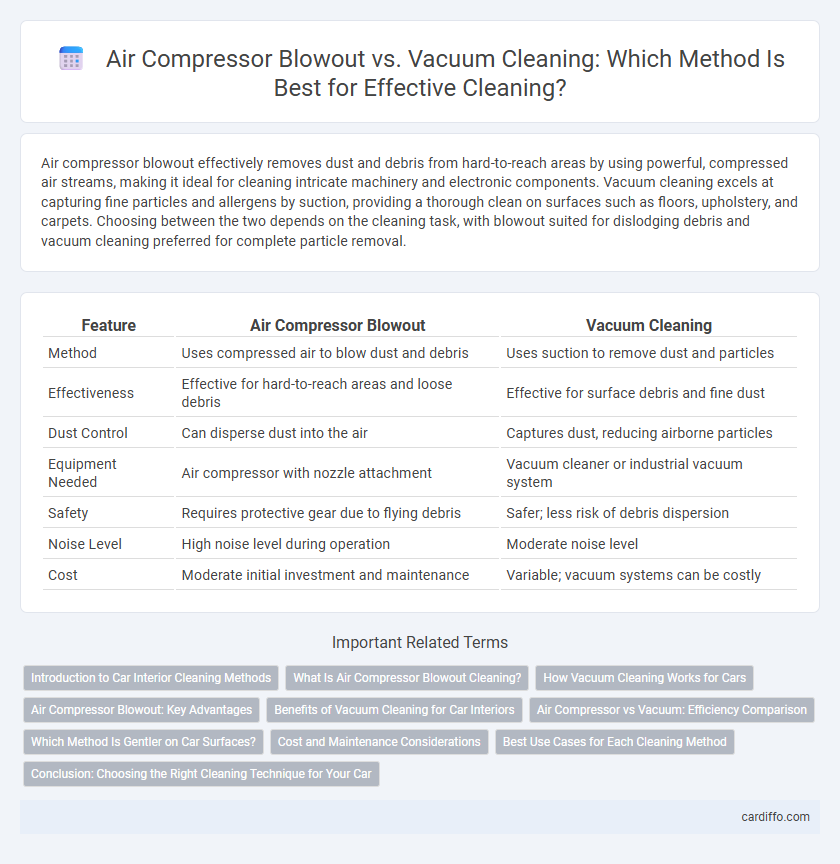Air compressor blowout effectively removes dust and debris from hard-to-reach areas by using powerful, compressed air streams, making it ideal for cleaning intricate machinery and electronic components. Vacuum cleaning excels at capturing fine particles and allergens by suction, providing a thorough clean on surfaces such as floors, upholstery, and carpets. Choosing between the two depends on the cleaning task, with blowout suited for dislodging debris and vacuum cleaning preferred for complete particle removal.
Table of Comparison
| Feature | Air Compressor Blowout | Vacuum Cleaning |
|---|---|---|
| Method | Uses compressed air to blow dust and debris | Uses suction to remove dust and particles |
| Effectiveness | Effective for hard-to-reach areas and loose debris | Effective for surface debris and fine dust |
| Dust Control | Can disperse dust into the air | Captures dust, reducing airborne particles |
| Equipment Needed | Air compressor with nozzle attachment | Vacuum cleaner or industrial vacuum system |
| Safety | Requires protective gear due to flying debris | Safer; less risk of debris dispersion |
| Noise Level | High noise level during operation | Moderate noise level |
| Cost | Moderate initial investment and maintenance | Variable; vacuum systems can be costly |
Introduction to Car Interior Cleaning Methods
Air compressor blowout and vacuum cleaning are two common methods used in car interior cleaning to remove dust, dirt, and debris from hard-to-reach areas. Air compressor blowout utilizes high-pressure air to dislodge particles from tight crevices, vents, and seams, while vacuum cleaning efficiently extracts loose contaminants from seats, carpets, and floor mats. Choosing the appropriate method depends on the specific interior surfaces and the type of dirt to ensure thorough cleaning and maintenance of vehicle hygiene.
What Is Air Compressor Blowout Cleaning?
Air compressor blowout cleaning uses high-pressure air to remove dust, debris, and contaminants from surfaces and hard-to-reach areas by blowing particles away rather than sucking them up. This method is effective for cleaning electronic components, machinery, and tight spaces where vacuum cleaning may be less efficient or potentially damaging. Unlike vacuum cleaning, blowout cleaning minimizes contact with delicate parts, reducing the risk of static buildup and ensuring thorough dust removal.
How Vacuum Cleaning Works for Cars
Vacuum cleaning for cars operates by creating negative pressure that sucks dirt, dust, and debris from surfaces into a collection bag or canister. The vacuum uses powerful suction generated by an electric motor to effectively remove particles from carpets, upholstery, and crevices. This method ensures thorough cleaning without dispersing contaminants into the air, making it ideal for maintaining interior car hygiene.
Air Compressor Blowout: Key Advantages
Air compressor blowout provides powerful and rapid removal of dust, debris, and contaminants from surfaces or equipment, making it highly effective for deep cleaning in industrial and automotive settings. Its ability to reach tight or hard-to-access areas ensures thorough cleaning without direct contact, reducing the risk of damage to delicate components. Compared to vacuum cleaning, air compressor blowout offers superior airflow pressure, enhancing efficiency in clearing stubborn dirt and maintaining optimal machinery performance.
Benefits of Vacuum Cleaning for Car Interiors
Vacuum cleaning effectively removes dirt, dust, and allergens from car interiors, reaching tight spaces and upholstery fibers with precision. Unlike air compressor blowouts that can disperse debris into the air, vacuum cleaners capture contaminants directly, promoting a healthier cabin environment. This method prevents damage to delicate surfaces and minimizes the risk of pushing particles deeper into cracks and vents, ensuring a thorough and safe cleaning process.
Air Compressor vs Vacuum: Efficiency Comparison
Air compressor blowout delivers high-pressure air to dislodge dust and debris quickly from hard-to-reach areas, making it highly efficient for spot cleaning and surface preparation. Vacuum cleaning excels in removing fine particles and allergens by generating strong suction, which captures dust thoroughly without dispersing it into the air. For overall cleaning efficiency, vacuums provide better containment and filtration, while air compressors offer speed and force for heavy-duty debris removal.
Which Method Is Gentler on Car Surfaces?
Air compressor blowout uses high-pressure air to remove dust and debris but can risk damaging delicate car surfaces or paint due to its force. Vacuum cleaning provides a gentler alternative, using suction to lift dirt without abrasive contact, minimizing the chance of scratches or surface wear. For sensitive car surfaces, vacuum cleaning is generally safer and more effective in preserving the vehicle's finish.
Cost and Maintenance Considerations
Air compressor blowouts require regular maintenance to ensure optimal pressure and prevent wear on components, often leading to higher operational costs due to air consumption and potential repairs. Vacuum cleaning systems generally incur lower maintenance expenses, relying on filters and routine dirt disposal without the need for pressurized air, making them cost-effective over time. Choosing between the two depends on budget constraints and the frequency and intensity of cleaning tasks, with vacuums offering economical advantages for continuous use.
Best Use Cases for Each Cleaning Method
Air compressor blowout is ideal for removing dust, debris, and moisture from hard-to-reach areas in machinery, electronic components, and automotive parts, where precision and pressure are crucial. Vacuum cleaning excels in collecting loose dirt, allergens, and fine particles from floors, carpets, upholstery, and office environments, offering efficient and contained debris removal. Selecting air compressor blowout or vacuum cleaning depends on the surface type, debris nature, and cleaning accessibility for optimal effectiveness in industrial or residential settings.
Conclusion: Choosing the Right Cleaning Technique for Your Car
Selecting the appropriate cleaning method for your car depends on the specific area and type of debris to be removed. Air compressor blowouts excel at dislodging loose dirt and dust from hard-to-reach crevices, while vacuum cleaning effectively extracts embedded particles and maintains interior upholstery cleanliness. Combining both techniques often yields the best results in comprehensive automotive cleaning and maintenance.
Air Compressor Blowout vs Vacuum Cleaning Infographic

 cardiffo.com
cardiffo.com